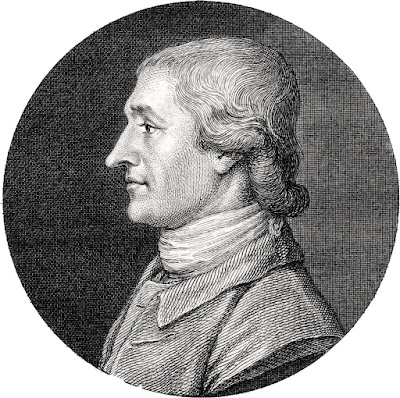This c. 1785 portrait of Charles Thomson by Joseph Wright hangs at Tudor Place in Washington DC.
Charles Thomson (November 29, 1729 – August 16, 1824) was an Irish-born Patriot leader in Philadelphia during the American Revolution and the secretary of the Continental Congress (1774–1789) throughout its existence. -- Wikipedia
Lossing, in 1857, gives us this portrait of Charles Thomson.
Albert Bobbett's picture of Thomson appeared in Lossing et al., Our Country in 1892.
That seems to follow this portrait drawn from life in Philadelphia by Pierre Eugène du Simitière, engraved by Benoît Louis Prévost in Paris, and published in 1783 (?). It belongs to the New York Public Library.
Thomson was the sole secretary of both the Continental Congress and the Confederation Congress. He is prominently shown in John Trumbull's painting of the signing of the Declaration of Independence.
That's him standing behind the desk next to John Hancock (sitting).
Although he appears in this painting and his name appears on some versions of the Declaration, Thomson is not considered a signer of the Declaration.
Hours after the declaration was signed, Congress appointed a committee to design a Great Seal for the United States. Franklin, Jefferson and Adams produced a complicated design that was tabled by Congress. After two more committees failed to produce a final design, Secretary Charles Thomson put together elements from the various proposals to produce this design which with some adaptation was adopted.in 1782. See this page at the Archives.
Thomson also suggested the Latin mottos Annuit cœptis “(It/He) favors our undertakings” and Novus ordo seclorum “New order of the ages”.
Before he became secretary to Congress, Thomson acted as secretary to Teedyuscung, the self-styled "King of the Delaware's" in 1758 during negotiations between the Lenape chief and the Penn family (the Easton Treaty). Thomson reported in his Enquiry into the Causes of the Alienation of the Delaware and Shawanese Indians from the British Interest that:
He died on August 16, 1824 and was buried at Harriton in Bryn Mawr PA. In 1838 his remains (and those of his wife Hannah) were moved to Laurel Hill Cemetery in Philadelphia and buried under a 16 foot obelisk.
The Epitaph, composed by John F. Waston, reads:
“As the Indian King had been for four or five Days (viz. from the Day before the publick Treaty began, to the Time of his delivering this Speech) kept almost continually drunk, it is not to be wondered that several Parts of his Speech, as it stands in the Minutes, appear dark and confused, as they did to the Governor; more especially as the Interpreter, at the Time the Speech was delivered, was dozed with Liquor and Want of Sleep.”In retirement, Thomson wrote a history of the American Revolution which he destroyed unpublished and produced a new translation of the bible from the Greek.
He died on August 16, 1824 and was buried at Harriton in Bryn Mawr PA. In 1838 his remains (and those of his wife Hannah) were moved to Laurel Hill Cemetery in Philadelphia and buried under a 16 foot obelisk.
 |
| Photo by Bill Coughlin HMdb |
The Epitaph, composed by John F. Waston, reads:
This monument
Covers the remains of the
Honourable
Covers the remains of the
Honourable
CHARLES THOMSON
The first, and long
The Confidential Secretary of the
Continental Congress,
And the
Enlightened benefactor of his country
In its day of peril and need.
Born November 29, 1729,
Died August 16 1824,
Full of honours and of years.
---
As a Patriot,
His memorial and just honours
Are inscribed on the page
Of his country's history.
---
As a Christian,
His piety was sincere and enduring,
His Biblical learning was profound,
As is shown by his translation of the Septuagint.
As a man,
He was honored
Loved and wept.
---
Erected
To the memory of an honoured
Uncle and Benefactor.
By his Nephew,
John Thomson, of Delaware.
Hic jacet
Homo veritatis et gratiæ
The first, and long
The Confidential Secretary of the
Continental Congress,
And the
Enlightened benefactor of his country
In its day of peril and need.
Born November 29, 1729,
Died August 16 1824,
Full of honours and of years.
---
As a Patriot,
His memorial and just honours
Are inscribed on the page
Of his country's history.
---
As a Christian,
His piety was sincere and enduring,
His Biblical learning was profound,
As is shown by his translation of the Septuagint.
As a man,
He was honored
Loved and wept.
---
Erected
To the memory of an honoured
Uncle and Benefactor.
By his Nephew,
John Thomson, of Delaware.
Hic jacet
Homo veritatis et gratiæ











No comments:
Post a Comment